April 17, 2025 | 20:55 GMT +7
April 17, 2025 | 20:55 GMT +7
Hotline: 0913.378.918
April 17, 2025 | 20:55 GMT +7
Hotline: 0913.378.918
In recent years, coffee growers in Tan Nghia commune (Di Linh district, Lam Dong) have often suffered damages due to prolonged drought. Many coffee areas have withered, shed leaves and fruits when watering is not guaranteed. Mr. Doan My, a farmer in Tan Nghia commune, said that when his family was struggling with the water issue, he received support from the VnSAT project.
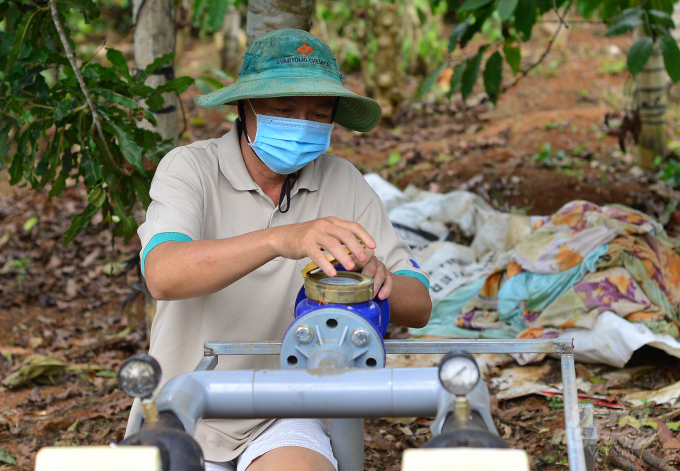
Thanks to the sprinkler irrigation system at the root, Mr. Le Ngoc Chanh's family (Tan Nghia commune, Di Linh district, Lam Dong) has a source of water to irrigate coffee in the dry season. Photo: Minh Hau.
The farmer said, the project supported the family with 50% of the installation cost for the irrigation system, pipes, sprinklers and instructed to operate the irrigation technique combined with fertilizing. Currently, the water source from the only borehole in the garden is enough for Mr. My's family to irrigate nearly 1ha of coffee, no longer worrying about water shortage as before.
Also in Tan Nghia commune, at the end of 2020, Mr. Le Ngoc Chanh's family was supported by the VnSAT project with the model of sprinkler irrigation at the root on an area of 1ha of coffee. According to Mr. Chanh, the investment cost for the system of machines, pipes, sprinklers... takes about 80 million VND, but the family only needed to reciprocate 40 million VND, the remaining is supported by the VnSAT project.
"My family has stuck with coffee farming since the 1990s and mainly watered it in the form of pumping water directly to the root. So when the system was installed, I was still worried about the efficiency, afraid of this style of irrigation. However, after a dry season, I realized that watering with a sprinkler system at the root not only saves money but also helps growth," said Mr. Le Ngoc Chanh.

The VnSAT project supports 50% of the installation costs for farmers implementing the sprinkler irrigation system at the root. Photo: Minh Hau.
According to the farmer, the sprinklers surround the coffee base and spray evenly. Each hour, one sprinkler can provide 60 liters of water and this water gradually penetrates into the ground, creating stable moisture so the microflora in the garden is maintained, the roots thrive even at the peak of the dry season.
Talking about the traditional way in the past, Mr. Le Ngoc Chanh said, the family has 3 hectares of coffee garden located on the hillside, so every time the dry season comes, the family has a hard time finding water sources and irrigation workers. To ensure water for the garden, he had to drill many wells. "When the well has water, the family assigns people or hires workers to take turns pulling pipes from one root to another. Irrigation for each hectare of the garden sometimes takes an entire day and still cannot be completed," said Mr. Le Ngoc. Chanh said.
In Nam Ban town (Lam Ha district, Lam Dong), Mr. Tran Van Xuat's family was supported by the VnSAT project to install a sprinkler irrigation system at the root on an area of 0.8ha of coffee. Thanks to this irrigation system, in the dry season, the trees in his family's garden are still lush, the rate of flowers and fruits is higher than that of traditional irrigation models. Seeing the effective benefits of sprinkler irrigation, his family invested capital to install it on the entire 3ha garden.
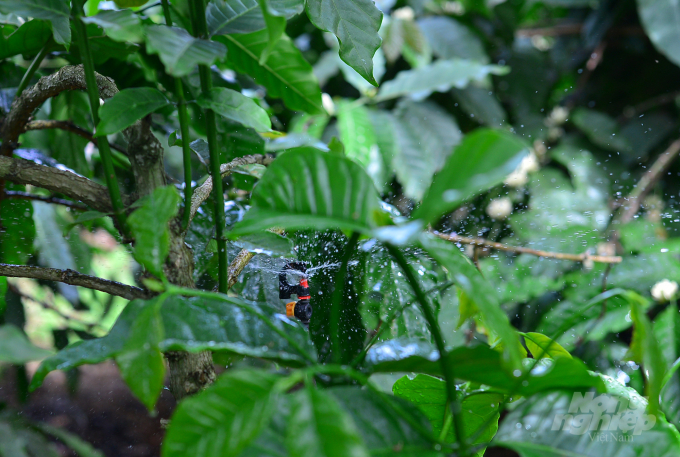
Water source is spread evenly on the garden floor to help plants absorb the most water. Photo: Dang Lam.
Mr. Xuat said, since the sprinkler irrigation system was installed, the family no longer had to worry about water shortage for irrigation and did not have to look for workers as before. Before the sprinkler irrigation was installed, every time the Tet holiday was over, the family had to hire nearly 10 workers just to ensure this stage. However, since the irrigation system completed, watering all 3 hectares of the garden only requires 3 workers. These 3 workers also do leisurely jobs such as starting- shutting down the engine, opening the valves in areas to be irrigated and checking the sprinklers.
In Lam Dong, the VnSAT project was implemented in 8 districts and cities with a scale of 16,500 hectares of coffee and 15,000 participating farmers. According to the VnSAT Lam Dong Project Management Board, the province called for the establishment of 41 farmer organizations, including seven cooperatives and 34 new cooperative groups for sustainable coffee production.
The total project implementation capital in this locality is about 211 billion VND, of which ODA capital is 132.9 billion VND, counterpart capital is 38.2 billion VND and private capital is 39.9 billion VND. The number of beneficiaries from the project is about 56,392 people. Farmers participating in the project increased profits by 20.73% compared to before and increased by 21.28% compared to farmers outside the project area.
According to Mr. Tran Van Xuat, the sprinkler irrigation system at the root has brought a lot of benefits, both contributing to saving water, saving labor costs, fertilize and promote plants' growth. According to Mr. Xuat, in the past, fertilizing coffee was only done in the rainy season. Therefore, there were times when the fertilizer has just been applied, the next day the heavy rain washed all of them away. This causes a large loss of fertilizer, causing cost losses and the plants are not guaranteed nutrition.
"When installing the sprinkler irrigation system, my family uses fertilizer mixed with water and then turns on the machine to make the fertilizer follow the water to the base of the tree. This type of fertilizer is convenient in that we can fertilize at anytime, any season of the year. The amount of fertilizer delivered to the base of the tree is just enough to penetrate into the soil for the plants to absorb, so it saves the amount of fertilizer and helps the plant to grow strongly," said Mr. Tran Van Xuat, Nam Ban town, Lam Ha district commented.
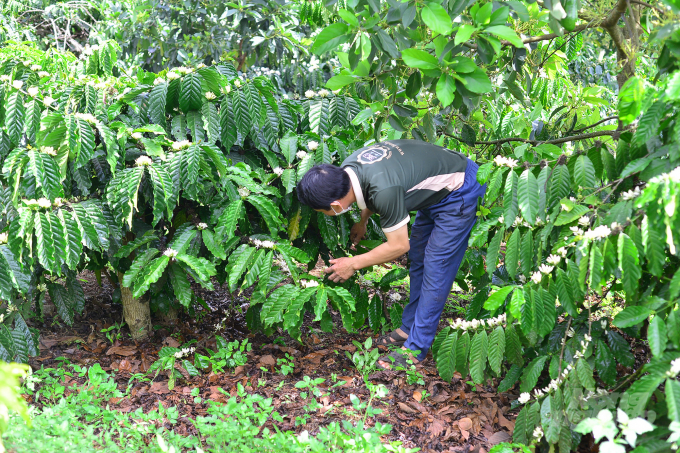
Through the sprinkler irrigation system at the root, people can both water and fertilize. Photo: Dang Lam.
Sharing the same opinion, Mr. Le Ngoc Chanh in Tan Nghia commune (Di Linh district, Lam Dong) said, when fertilizing through the sprinkler irrigation system, the amount of fertilizer is calculated specifically. This source of fertilizer is neither too much nor lacking, so the plant can absorb the most efficiently, the yield and quality of coffee therefore also increase.
In the past, it took many days to fertilize a 1 hectare garden because people plowed the land and carried bags of fertilizer to fertilize. In particular, in the rainy season, the soil in Tan Nghia (Di Linh) area becomes soft, so transporting and fertilizing is extremely difficult. "Now just add fertilizer to the water according to a specific formula, start the machine and everything is done," said Mr. Chanh excitedly.
According to Mr. Chanh, fertilizing through an economical irrigation system creates uniformity so the plants in the garden also grow evenly and give stable yields. In addition, garden owners can fertilize at any time, without having to wait to fertilize in the rainy season as the traditional method.
Mr. Le Ngoc Chanh said: "Whenever I see a plant weakening and needing to absorb, I put fertilizer in the machine to fertilize it. Regardless of the season, this system fertilizes and the plants absorb it all. That's why we can be active in stimulating the growth, development or slowing the growth of plants to create the highest yield and quality".
Currently, with the benefits that the economical irrigation system brings, many coffee growing households outside the VnSAT project also aim to learn and invest to develop.
Mr. Nguyen Minh Ngoc, Director of Tan Nghia Cooperative (Tan Nghia commune, Di Linh district) said that in the past, the VnSAT project has supported 3 members of the cooperative to implement 3 models of sprinkler irrigation at the root. This is an extremely practical activity, helping people stabilize production and improve product value. The sprinkler irrigation system at the root has helped farmers to develop economically. Saving both water and labor.
According to Mr. Nguyen Minh Ngoc, Tan Nghia commune is in an area affected by climate change, dry land, reduced irrigation water in the dry season. Therefore, for many years in a row, the coffee production of the people was affected by plants withering, decrease in productivity, affecting the economic life of the people.
When people apply the sprinkler irrigation system at the root to production, people no longer have to suffer damages due to drought. Water is saved while the humidity of the garden is always maintained, helping plants grow stably. From these aspects, farmers can drastically reduce their initial costs, increase their income and improve their profits.
Translated by Nguyen Hai Long
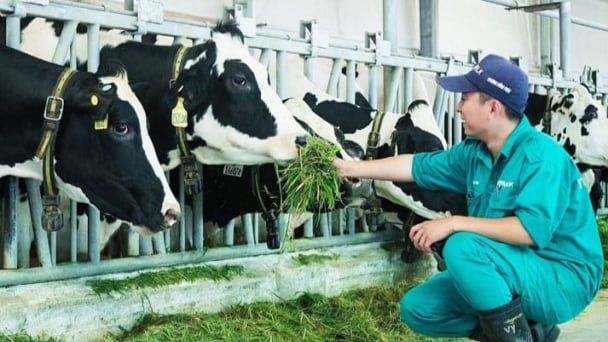
(VAN) According to Tong Xuan Chinh, Deputy Director of the Department of Livestock Production and Animal Health, Vietnam’s dairy cattle industry must overcome seven major challenges to achieve sustainable development.
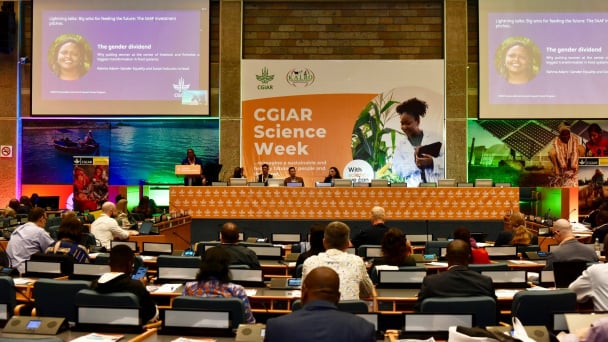
(VAN) The CGIAR’s Sustainable Animal and Aquatic Foods (SAAF) program represents a new approach that emphasizes the transformation of food systems toward sustainability.
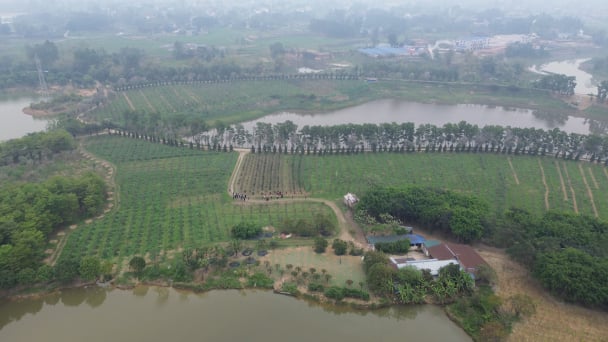
(VAN) Scientists assume that industrial agriculture has been 'outdated.' As a result, a comprehensive overhaul or a revolution in the direction of embracing ecological agriculture is needed.
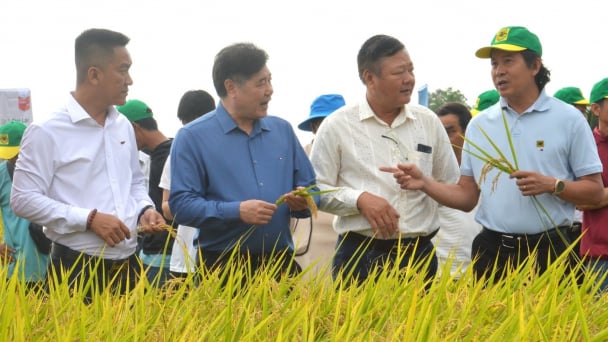
(VAN) The results from pilot fields are catalyzing the expansion of the One million hectares of high-quality, low-emission rice project in Kien Giang.
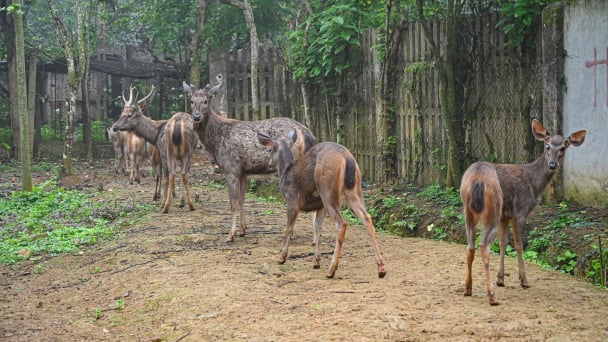
(VAN) On the morning of April 11, Cuc Phuong National Park received 18 individuals of endangered and rare wild animals from Da Nang city.
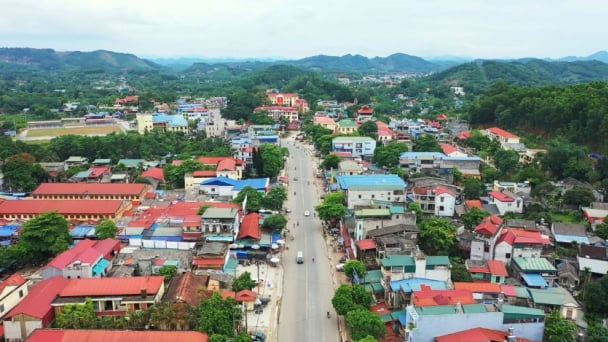
(VAN) FAO supports Vietnam in enhancing survey sampling techniques for the 2025 nationwide agricultural and rural census.

(VAN) By participating in the green transition, manufacturers become an indispensable part of the circular economy, contributing to resource optimization and environmental protection.